Swimming in the Dead Sea: A Bucket List Experience
Have you ever dreamed of crossing an activity off your bucket list that is both thrilling and surreal? If so, swimming in the Dead Sea should be on your list.
Located between Israel and Jordan, the Dead Sea is a natural wonder with extraordinary features. It is the lowest point on Earth, with a highly concentrated salt content renowned for its curative properties. As such, it is considered a popular destination for tourists, athletes, and adventure-seekers.
So what makes swimming in the Dead Sea such a bucket list experience? Keep reading to find out!

Introduction
Brief Explanation of the Dead Sea
The Dead Sea is a natural wonder that attracts visitors from all over the world. It is the lowest point on Earth, where water and salt meet to form the largest natural lake in the world by surface area. Located between Jordan to the east and Israel and Palestine to the west, the Dead Sea is also known as the Salt Sea. It is named so because it has no outlet for water other than evaporation, meaning no life can survive in its waters. Surrounded by mountains on three sides, the Dead Sea offers breathtaking views and diverse wildlife.
One of the main reasons the Dead Sea should be on your bucket list is its health benefits. With a salt content of about 33.7%, which is eight times as salty as ocean water, the Dead Sea is a natural disinfectant that helps soothe skin irritations and has been known to have anti-ageing properties. Swimming in its waters can be therapeutic for reducing oiliness and improving visible symptoms such as blemishes.
The best time to visit the Dead Sea is from March to May or late September to November when the temperatures are moderate and rainfall is minimal. It is recommended to pack sunscreen and protective footwear, as well as something you don't mind getting tarnished, as the mud from the Dead Sea can discolour clothing.
Overall, swimming in the Dead Sea is a bucket-list experience that offers relaxation and healing properties for the skin. It is a destination that should not be missed, so start planning your trip soon! [1][2]

Importance of having it on your bucket list
Swimming in the Dead Sea is an experience that should be on everyone's bucket list. The Dead Sea is a stunning natural wonder and offers numerous health benefits. It is the lowest point on Earth, located 1,300 feet below sea level, and is the largest natural lake in terms of surface area. This unique geographical feature alone makes it a must-visit destination.
One of the main reasons to add the Dead Sea to your bucket list is the incredible health benefits it offers. The high salt content in the Dead Sea, about 33.7%, provides therapeutic properties for the skin. Floating in the dense water helps to pull excess oil from the skin and soothe irritations like bug bites or stings. It also has anti-ageing properties and can reduce oiliness and blemishes for people with oily or acne-prone skin.
The Dead Sea is also renowned for its healing mud, rich in minerals that offer various benefits. These minerals include magnesium, which helps regulate sleep and relax muscles. Potassium is important for nerves and muscles, and calcium is crucial for bone health. The mud is used to treat skin conditions like psoriasis and eczema and has also been found effective for asthma relief.
Besides the health benefits, the Dead Sea is a great place to swim due to its still and dense water. You can effortlessly float in the water, and the high density combined with the heat from the sun creates an extraordinary experience. Also, the area has luxurious hotels that offer spa treatments and access to private beaches, making it a great place for relaxation and rejuvenation.
Overall, swimming in the Dead Sea is a unique and unforgettable experience that provides stunning views and numerous health benefits. It should be on your bucket list for a truly memorable vacation. [3][4]

The History and Science of the Dead Sea
Geographical information
The Dead Sea between Jordan and Israel is a unique natural wonder that should be on everyone's bucket list. Situated 1300 feet below sea level, it holds the title of being the lowest point on Earth. This salt lake is known for its high salt concentration, making it impossible for fish and aquatic plants to survive. Due to this, it has been dubbed the Dead Sea.
The formation of the Dead Sea is a result of its location in an arid desert, where water flowing in from the Jordan River has no way to flow out. As a result, the water evaporates quickly, leaving behind a high concentration of salt. The lake's salinity levels are nearly nine times saltier than the ocean.
Swimming in the Dead Sea is a remarkable experience, thanks to its high salt density. You effortlessly float on the water without any effort, making it feel like you're bobbing on a fishing line. The mineral-rich waters of the Dead Sea have therapeutic properties and are known to benefit those with chronic skin conditions, asthma, eczema, and even heart disease.
The Dead Sea is best visited from March to May or late September to November when temperatures are moderate, and rainfall is minimal. It's important to wear protective footwear when entering the water to avoid sharp salt crystals. Visitors can also enjoy the breathtaking views of the Dead Sea's surroundings, explore nearby attractions like Mount Nebo and Bethany Beyond, and make the most of their trip by choosing a suitable hotel or opting for a day tour.
So why wait? Start planning your trip to the Dead Sea soon and experience the incredible sensation of floating on its mineral-rich waters while taking in the beautiful scenery. [5][6]
Explanation of how the Dead Sea is formed
The Dead Sea, located in the desert in southern Israel and bordered by Jordan to the east, is a salt lake that is the lowest point on Earth. Its unique geological origins can be traced back to millions of years ago when the area was repeatedly flooded by water from the Mediterranean Sea. Over time, the land between the lagoon and the sea rose, creating a landlocked lake. Shifts in tectonic plates and the harsh desert climate further formed the Dead Sea as we know it today.
What sets the Dead Sea apart from other bodies of water is its extreme salinity, making it almost impossible to dive. The high concentration of salt and minerals in its water, air, and land are renowned for their therapeutic qualities. Visitors have been flocking to the Dead Sea for thousands of years to benefit from its healing properties, particularly for skin conditions like psoriasis and vitiligo. The unique combination of minerals and salts in the Dead Sea mud is believed to improve blood circulation and rejuvenate the skin.
Given its fascinating geological and historical background, the Dead Sea is a must-visit destination. The best time to plan your trip is during the off-season to avoid crowds and enjoy the healing benefits of the sun and salt. Don't forget to pack essentials like sunscreen, a hat, and drinking water to stay hydrated. Finding a good spot to swim is easy, but remember to avoid getting the water in your eyes or throat due to its high salinity. Overall, a trip to the Dead Sea promises a unique and unforgettable experience. So why not start planning your visit soon? [7][8]

Health benefits of swimming in the Dead Sea
Swimming in the Dead Sea offers numerous health benefits, making it a truly unique and rejuvenating experience. The water's high salt content, about 33.7%, is eight times saltier than ocean water. This high salt concentration, along with the lack of fresh water and dampness, creates an environment that effectively pulls excess oils from your skin, leaving it feeling refreshed and glowing.
The saltwater also acts as a natural disinfectant, soothing skin irritations like bug bites or stings. It even has anti-ageing properties, inhibiting collagen breakdown and keeping your skin youthful. For those with oily or acne-prone skin, the Dead Sea's unique properties can reduce oiliness and improve visible symptoms like blemishes.
Additionally, the mineral-rich mud found in the Dead Sea has healing powers. It contains minerals like magnesium, potassium, calcium, bromine, and sulfur, which have been shown to regulate sleep, relax muscles, support immune health, and even alleviate skin conditions like psoriasis and eczema.
Swimming in the Dead Sea is good for your body and provides an unparalleled swimming experience. The water's high density makes it almost impossible to sink, allowing you to float effortlessly. And let's not forget the breathtaking views and incredible sunsets that make the Dead Sea a truly unforgettable destination.
So why wait? Start planning your trip to the Dead Sea and experience these health benefits for yourself. [9][10]

Preparation for the trip
Best time to visit
The best time to visit the Dead Sea is from March to May or late September to November. During these months, the temperatures are moderate, and rainfall is minimal, making it the ideal time to enjoy the unique experience of swimming in the Dead Sea.
The summers can be incredibly hot, reaching 40 degrees Celsius, which may not be very refreshing for floating in the water. However, if you can handle the heat, visiting during the summer can also be a good option as there are fewer tourists and lower accommodation prices.
On the other hand, visiting in December and January might not be as pleasant as the temperatures are particularly cold. It's important to note that December and January are also the peak tourist season, so the beaches and resorts may be crowded.
To make the most of your trip to the Dead Sea, it's recommended to plan your visit during the optimal months when the weather is ideal for floating, and the tourist crowds are manageable. [11][12]

Packing list
When planning a trip to the Dead Sea, it's important to pack appropriately to ensure a comfortable and enjoyable experience. Here is a suggested packing list to help you maximise your time swimming in the Dead Sea.
First and foremost, don't forget to pack your swimsuit! The Dead Sea is famous for its buoyancy, and swimming in mineral-rich waters is a once-in-a-lifetime experience. It's also recommended to bring water shoes or sandals to protect your feet from the salt crystals and sharp rocks found along the shoreline.
Sun protection is essential in the intense heat of the Dead Sea region, so be sure to pack plenty of sunscreen with a high SPF. A wide-brimmed hat and sunglasses will also provide additional protection from the strong sunrays reflecting off the water.
Since the Dead Sea is located in the Middle East, temperatures can soar during summer. Lightweight and breathable clothing, including loose-fitting shirts and pants, is highly recommended to stay cool and comfortable during your visit. It's also advisable to bring a lightweight towel, as the salt content in the water can leave your skin feeling slightly sticky.
To stay hydrated in the dry climate, don't forget to bring a reusable water bottle. Drinking plenty of water is essential to avoid dehydration, especially if you plan to spend a considerable amount of time swimming or lounging by the sea.
Lastly, don't leave home without a camera or smartphone to capture the breathtaking views and unique moments during your time at the Dead Sea. The stunning landscapes and serene waters deserve to be documented and cherished.
By packing thoughtfully and using this checklist, you'll be well-prepared for a memorable and fulfilling trip to the Dead Sea. So start planning your adventure, and get ready to tick off this bucket.

Cost of the trip
When planning a trip to the Dead Sea, it's important to consider the cost of the trip. While the experience itself is free, there are other expenses to consider. One of the biggest expenses is accommodation. There are several luxury hotels if you want to spend the night and have extra time for relaxation. These hotels offer a range of amenities and can provide a truly luxurious experience. However, if you're on a budget, more affordable options are also available.
Transportation is another cost to consider. Some buses offer daily rides to the Dead Sea for a minimal fee if you're staying in Amman. Another option is to rent a car and drive yourself, which gives you more flexibility and the opportunity for a road trip. Alternatively, you can hire a driver, a cost-effective option if you're travelling with a group and can split the cost.
Lastly, budgeting for meals and other expenses during your stay is important. Some hotels offer package deals that include transportation, lunch, and beach access for a fixed price. However, if you choose to eat out or explore the local cuisine, it's important to factor that into your budget.
Overall, the cost of the trip to the Dead Sea will vary depending on your preferences and budget. However, with proper planning and research, it's possible to have a memorable and affordable experience at this bucket list destination. [15][16]

Tips on swimming in the Dead Sea
How to float on Dead Sea water
Floating on the Dead Sea water is a unique and incredible experience you should try when visiting this iconic destination. The high density of salt in the water makes it almost impossible to sink so that you can float effortlessly and enjoyably. To float on the Dead Sea water, all you need to do is lean back and let the buoyancy of the water do the work for you. No water wings or life vests are needed!
As you walk into the water, which initially feels like any other lake, you will begin to feel the strange sensation of effortlessly floating like a fishing bobber. This is because the lake's salinity is approximately 34%, much higher than ocean water's salinity. Our bodies are less dense than the sea, so we naturally float in the Dead Sea.
It's important to note that while floating on the Dead Sea water is a fun and exciting activity, there are some precautions to remember. Avoid splashing the water into your eyes or opening cuts, as the high salt content can cause discomfort. Additionally, it is recommended to limit your time in the water to around 10-15 minutes at a time to prevent any discomfort or irritation from the minerals and salt.
Overall, floating on the Dead Sea water is a must-do experience you won't find anywhere else. So, don't miss out on this incredible opportunity when planning your trip to the Dead Sea. [17][18]

Finding a good spot to swim
Regarding finding a good spot to swim in the Dead Sea, Ein Bokek is the best place in Israel. It offers everything you want, from bathrooms and changing areas to showers and lifeguards. It's also a great spot to apply the famous Dead Sea mud, known for its skin benefits.
However, I recommend venturing out by car if you prefer a more secluded and authentic experience. There are plenty of spots along the coast where you can pull over and dip in the sea. Just be cautious of sharp, salty rocks when accessing the water.
Important safety tips
One important thing to note is that due to the high salt content of the sea, it's not recommended to swim for long periods. The water can be quite harsh, especially for sensitive skin. It's best to limit your time in the water and avoid putting mud on your face. Ensure to wash off with fresh water and apply moisturiser afterwards to keep your skin hydrated.
Unusual activities at the Dead Sea
You can even try diving if you're looking for unusual activities at the Dead Sea. While I haven't personally experienced it, I've heard it's a completely different and unique experience. And if you're interested in capturing those picture-perfect moments, I suggest bringing your drone. It's a great way to get some stunning aerial shots of the sea and yourself floating on the surface.
The Dead Sea: A bucket-list destination
Overall, the Dead Sea offers a truly bucket-list-worthy experience. With its unique beauty and the magical feeling of floating at the lowest point on Earth, it's a must-visit destination. So, start planning your trip soon and prepare for an unforgettable Dead Sea adventure. [19][20]

Encouragement to plan your trip to the Dead Sea soon.
Are you ready to embark on an unforgettable adventure? The Dead Sea awaits, beckoning you to experience its wonders. From the moment you step foot in this unique destination, you'll be captivated by its beauty and intrigued by its history.
Swimming in the Dead Sea is a bucket list experience that offers a chance to float effortlessly in its salty waters and numerous health benefits. The mineral-rich composition of the water is known to soothe and heal various skin conditions, making it a natural spa for those seeking rejuvenation.
But the Dead Sea is more than just a body of water; it's a geographical wonder. Situated 1300 feet below sea level, it is the lowest point on Earth. Breathtaking landscapes and scenic views surround the lake, adding to the allure of your visit.
Now is the perfect time to plan your trip to the Dead Sea. The best time to visit is from March to May or late September to November when temperatures are moderate, and there is minimal rainfall. So pack your essentials, including protective footwear and swimwear. You don't mind getting a little dirty and don't forget to bring some Dead Sea mud back home for its therapeutic benefits.
Whether you're looking to embrace the natural healing properties, float effortlessly in the buoyant waters, or bask in the beauty of this unique destination, the Dead Sea promises an experience like no other. So start planning your trip today and get ready for an adventure you'll never forget [21][22]
